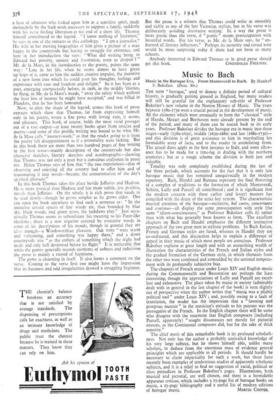Music to Bach
Music in the Baroque Era. From Monteverdi to Bach. By Manfred F. Bukofzer. (Dent. 30s.)
THE term "baroque" used to denote a definite period of cultural history, is gradually gaining ground in England, but many readers will still be grateful for the explanatory sub-title of Professor Bukofz,er's new volume in the Norton History of Music. The years between 1580-1730 were a crucial period in the development of music. All the elements which were eventually to form the "classical" style of Haydn, Mozart and Beethoven were already present by the end of the period, and many of them can be traced back to its early years. Professor Bukofzer divides the baroque era in music into three stages—early (1580-1630), middle (163o-168o) and late (168o-173o)- and this division is of great assistance to him in marshalling his formidable array of facts, and to the reader in assimilating them. The actual dates apply in the first instance to Italy, and some allow- ance has to be made for a time-lag in dealing with the northern countries ; but as a rough scheme the division is both just and valuable.
Tonality was only completely established during the last of the three periods, which accounts for the fact that it is only late baroque music that has remained unequivocally in the modern repertory. Bach, Handel and Rameau represent the final flowering of a complex of traditions to the formation of which Monteverdi, Schiitz, Lully and Purcell all contributed' and it is significant that the modern concern with these earlier (and lesser) masters has coincided with the decay of the strict key system. The characteristic musical creations of the baroque—recitative, bel canto, concertante and continuo—all display the same preoccupation with style (the same "idiom-consciousness," as Professor Bukofzer calls it) rather than with what has generally been known as form. The excellent chapters on Bach and Handel emphasise the different instinctive approach of the two great men to stylistic problems. In Bach Italian, French and -German styles are fused, whereas in Handel they are co-ordinated, and this distinction helps to explain a difference of appeal in their music of which most people are conscious. Professor Bukofzer explains at great length and with an astonishing wealth of illustration the characteristics of the French and Italian styles and the gradual formation of the German style, in which elements from the other two were combined and remoulded by the national tempera- ment with its profoundly subjective bias.
The chapters of French music under Louis XIV and English music during the Commonwealth and Restoration are perhaps the least interesting, though the appreciations of Lully and Purcell are excel,- lent and exhaustive. The place taken by music in society (admirably dealt with in general in the last chapter of the book) is seen slightly out of perspective when the author writes that "music was a pliable political tool" under Louis XIV ; and, possibly owing to a fault of translation, the reader has the impression that a "fawning and pompous manner" in the musician's attitude to his patrons was the prerogative of the French. In the English chapter there will be some who disagree with the statement that English composers (including Purcell, apparently) " sought dissonances not merely for pictorial reasons, as the Continental composers did, but for the sake of thick sonority."
The chief merit of this remarkable book is its profound scholarli- ness. Not only has the author a probably unrivalled knowledge of his very large subject, but he shows himself able, unlike many scholars, to deduce from the enormous mass of evidence general principles which are applicable to all periods. It Should hardly be necessary to claim impartiality for such a work, but there have recently been examples of tendentious studies of apparently scholastic subjects, and it is a relief to find no suggestion of racial, political or class. prejudices in Professor Bukofzer's pages. Illustrations, both musical and pictorial, are well chosen, and there is a formidable apparatus criticus, which includes a 15-page list of baroque books on music, a 25-page bibliography and a useful list of modern editions


































 Previous page
Previous page